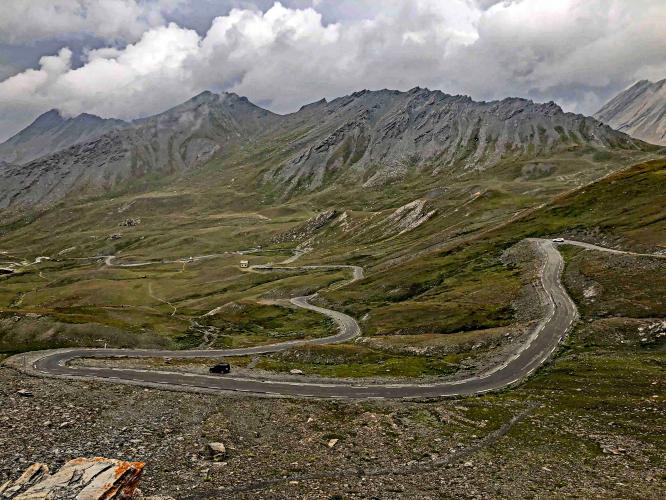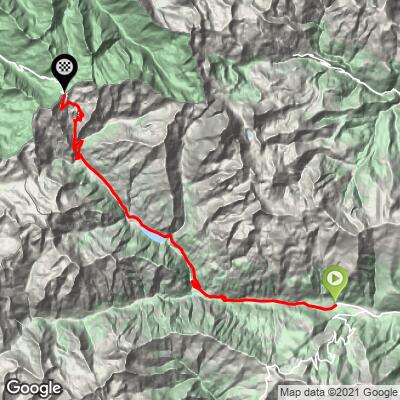![Cycling Colle dell’Agnello, France and Italy Cycling Colle dell’Agnello, France and Italy - long road winding it's way up mountainside, French and Italian alps]()
Cycling Colle dell’Agnello, France and Italy
Ride 30 kilometers gaining 1,750 meters at 5.8% average grade.
At 2,744 meters, Col delle Agnello (as it is called from the Italian side; Col Agnel from the French side) is the third highest paved pass in the Alps, coming in after Passo dello Stelvio (2760m), and Col de L’Iseran (2770m). Since this pass is on the border of France and Italy, it is the highest “international pass” in Europe.
The upper two-thirds of this climb are simply spectacular. The first several miles are on a busier portion of SP 105 and consideration could be given to beginning at the 9 mile/14.5 km point at Casteldelfino, or where many mountain bikers park along the road at the southern end of Lago articiale di Castello (14 miles/22.5 km with 9.6/16 remaining at 8.4% average grade).
![Cycling Colle dell’Agnello, France and Italy Cycling Colle dell’Agnello, France and Italy - photo collage, many road signs, mountain roadway, French and Italian Alps, PJAMM Cyclist standing with bike in front of sign for border of France and Italy, PJAMM Cycling logo in corner]()
The upper portion of this climb into and past Chianale (12 miles / 20 km) are simply spectacular, and quite challenging. From the beginning of the first tornante just past Chianale to the pass, we average a challenging 10.3% average grade for 5.4 miles / 9 km. The summit of this climb is at the Italian/French border.
![Cycling Colle dell’Agnello, France and Italy Cycling Colle dell’Agnello, France and Italy - photo collage, Cottian Alps, French Alps, Italian Alps, roadway snaking through mountainsides, green pastures, pink flowers, road sign for Agnello, PJAMM Cycling logo in corner]()
This gorgeous bike climb is in the Cottian Alps subrange of the Alps.
![Cycling Colle dell’Agnello, France and Italy Cycling Colle dell’Agnello, France and Italy - photo collage, Cottian alps, roadway switchbacks through mountainside, French Alps, Italian Alps, PJAMM Cycling logo in corner]()
![Cycling Colle dell’Agnello, France and Italy Cycling Colle dell’Agnello, France and Italy - photo collage, signs for Chianele, French Alps, Italian Alps, PJAMM Cycling logo in corner]()
Chianale is at the 20 kilometer mark.
20 kilometers to Chianale = 4%.
10 kilometers after Chianale = 9.8%.
![Cycling Colle dell’Agnello, France and Italy Cycling Colle dell’Agnello, France and Italy - stone sign on mountain at border of France and Italy]()
The highest international paved pass in Europe.
![Cycling Colle dell’Agnello, France and Italy Cycling Colle dell’Agnello, France and Italy - photo collage, sticker covered road signs at mountain summit, stone sign at border of France and Italy, long roadway snaking its way through mountainsides, PJAMM Cycling logo in corner]()
Third highest paved pass in Europe.
Giro d’italia and Tour de France History
Tour de France
Giro d'Italia
(Tables from Wikipedia)
As of 2020, this climb has been the Cima Coppi of the Giro 3 times (2000, 2007, 20016; designated but diverted from the top due to avalanches in 1995) since that designation was first introduced in 1965 to honor arguably the Giro’s greatest participant of all time:
“The Cima Coppi is the title given to the highest peak in the yearly running of the Giro d'Italia, one of cycling's Grand Tour races. The mountain that is given this title each year awards more mountains classification points to the first rider than any of the other categorized mountains in the race.
The categorization was first introduced for the 1965 Giro d'Italia in honor of the late Fausto Coppi who won five editions of the Giro d'Italia and three mountain classification titles during his career. It was first announced on 22 April 1965 by then race director Vicenzo Torriani that the highest peak would award two times as many mountains classification points. Torriani thought of possibly awarding time bonuses to the first to summit the mountain; however, after many dissenting opinions, he opted to go award more mountains classification points.
The Cima Coppi changes from year to year, depending on the altitude profile of the Giro d'Italia, but the Cima Coppi par excellence is the Stelvio Pass, which at 2758 m is the highest point ever reached by the Giro. The Stelvio has been used in the 1972, 1975, 1980, 1994, 2005, 2012, 2014 and 2017 editions. It was also scheduled in 1965, 1988, and 2013, but in each case the course was modified due to weather conditions, with various effects on the Cima Coppi designation.” (Cima Coppi)
2016 Stage 19 Report, Cycling News:
27 May 2016 – Pinerolo - Risoul 162 km (97 mi)
“The climax of the Giro d'Italia began with a brutal stage from Pinerolo to the French ski resort of Risoul. The route took the riders over the highest point of the race, the Cima Coppi, the Colle dell'Agnello. The sun was out at the start but the scene was very different at the top of the Cima Coppi, with huge banks of snow flanking the roads at its highest points.
There was no hanging about when the flag dropped and the peloton set off at a blistering place that made the formation of a break a very difficult task. The stage's parcours built up gradually, with the Colle dell'Agnello finally rearing up at around 40 kilometres into the day. Attacks were relentless but the elastic didn't snap until midway up the Agnello with a large group of 28 riders breaking clear of the peloton.
Among those out front were teammates of Nibali, Chaves and Valverde, including Michele Scarponi, Ruben Plaza and Rory Sutherland respectively. Unfortunately for Nippo-Vini Fantini, the leader of the mountains classification Damiano Cunego was not one of the 28 that broke clear. It wasn't long before the break began to splinter and the strongest few emerged at the front.
Ulissi and Scarponi moved clear on the steepest ramps, taking Katusha's Egor Sillin with them. Scarponi kicked again, distancing his companions to secure the honour of taking the Cima Coppi prize, just over five minutes ahead of the peloton. The main contenders were not concerned about the Italian, however, as they fought their own battle. Riding into the snow and the fog that shrouded the top of the climb, the battle for the overall title began to take shape.
After suffering earlier in the week, Chaves set the pace in the GC group and forced some early splits. Only his closest rival Valverde was able to stay with him initially, as the rest of the group were forced to chase him down. Another small attack from the diminutive Colombian was shut down by the maglia rosa Kruijswijk, who still looked comfortable thus far. After sticking with Chaves at first, Valverde began losing distance.
Valverde had lost some 40 seconds by the time that the Chaves hit the top of the Colle dell'Agnello
The stage was taking shape as they began the long descent but it was blown apart on a seemingly innocuous corner. The snow still banked high, Kruijswijk ploughed into it after overcooking it on a corner with 50 kilometres to go. His impact sent snow powder flying before Kruijswijk himself went spinning and his bike skidded down the road. He quickly dusted himself off and picked up his bike but it was damaged and it would take some time to get going again.
On his way again, Kruijswijk was still ahead of Valverde but he had lost precious time to Nibali and Chaves who were now scything their way town the fast and twisting descent. Even the Movistar rider would pass him, when Kruijswijk was forced to stop for a second time following his crash and the chase would now be critical. The Dutchman caught several groups along the way but nobody was willing or strong enough to help him in his efforts.
In the meantime, another general classification hopeful was seeing their ambitions go down the pan. Ilnur Zakarin (Katusha) suffered a heavy crash that send him skidding 20 metres into the grass on the side of the road. It looked very bad at first, but reports soon came in that the damage was a broken collarbone. Not serious compared to initial fears but enough to send him out of the race.
Up front, Scarponi had waved goodbye to escape companion Maxime Monfort (Lotto-Soudal) to help Nibali. They would see each other very soon though, when Scarponi paced Nibali, Chaves and others back to the Belgian with 10 kilometres to go. The veteran rider soon pulled off and opened the door for Nibali's first attack.
As Nibali surged forward, the same couldn't be said for Kruijsiwjk who was being dropped by white jersey Bob Jungels, who he had linked up with on the descent. The gap didn't immediately balloon out as Kruijswijk's resolve still held but it wouldn't be long before he was watching his pink jersey slip from his grasp.
Two more attacks from Nibali rid him of Chaves and allowed him to solo to a much-needed victory. Nibali is now just 40 seconds behind Chaves as they enter the final day in the mountains.”
![Cycling Colle dell’Agnello, France and Italy Cycling Colle dell’Agnello, France and Italy - PJAMM Cyclist stands with bike in front of stone sign for border of France and Italy]()
Thank you Ard Oostra!!

 We've partnered with Sherpa-Map.com to bring you the best route planning tool. With a PRO Membership you can use this climb as a reference when creating your route.
We've partnered with Sherpa-Map.com to bring you the best route planning tool. With a PRO Membership you can use this climb as a reference when creating your route. 

